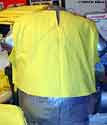 |
 |
 |
 |
 |
 |
 |
Please note that I will use the terms leine & shirt interchangably, and same for ionar & jacket.
The Construction:
The Ionar:
The leine is made from yellow 100% linen of medium weight. The ionar is green 100% wool twill. the ionar is lined in a matching colored, firmly woven cotton. As this garment is to be worn at California Renaissance faires, comfort in the heat was an important consideration. Thankfully, natural fibers are both comfortable, and historically accurate.
In the ionar, there is an inner support provided by hair canvas. I chose not to put any canvas in the cowl area as the woodcuts didn't seem to show a stiffened collar, as we would normally do in a modern suit jacket. I also used the lining material as the collar for visual interest.
The ionar has a green wool skirting around the waist. The ionar skirting was several yards long and about 18" wide. This was sewn as a very long rectangular piece. It had wool on one side, and the lining on the other. The tube was then pressed flat, cartridge pleated with two rows of stitching, and then carefully sewn onto the waist area by hand, both on the tops and bottoms of each pleat. Only the closest row of thread to the body remained after sewing onto the ionar, in order to relax the pleats. Liam did not want the "waist ruff" to stand away from the body like a "stiff tutu".
The ionar sleeves are a typical Irish hanging sleeve. This means that the bottom is not sewn together to allow the leine sleeves to hang beneath them.
The Leine:
The body of the leine is a basic shirt. I made it a split front, and attached interfacing to the bottom hemline to support the weight of the skirt.
The biggest job was sewing, marking, pleating and attaching the skirting on the leine. In order for the upper skirts to stand away from the body, and for all that mass of linen to fit onto the shirt base, I chose to cartridge pleat the skirt.
The leine skirting width is from his actual waist to above his knee. I cut and finished long strips of material, sewed them together, then finished the edges. As shown in the photos, I then marked and handsewed three rows of stitch lines. The skirt took most of the 10 yards of 60" wide linen I had. After constructing this version of a leine, I can understand where the excessive yards of linen might have been historically placed.
Apparantly, the linen use on a garment was so excessive, there was a limitation on the amount of linen an Irishman could wear in his shirt.
An Act of Parliament at Dublin in 1541 limited the amount of linen cloth to be worn in the shirts of various classes thusly:
Noblemen 20 cubits (about 10 yards)
Vassal or horseman 18 cubits (9yds)
Kerne (turbarius) or Scot 16 cubits (8yds)
Groom, messenger or other servant of lords 12 cubits (6yds)
Husbandman or labourer 10 cubits (5yds)
~ What the Irish Wore,
www.reconstructinghistory.com3
It is thought the highest noblemen actually wore 25 to 30 ells of linen on a shirt, and didn't pay much attention to the laws.
As can be seen in the photos, this was a large amount of material to fit around the body. The shirt itself had to be reinforced with interfacing to hold it all without ripping. I think a stronger interfacing or selvedge fabric should be used next time. The pleats were only attached at one edge, much like a woman's court gown skirts are attached.
Previous | Next
Bibliography and Internet Sources:
- Dunlevy, Mairead: Dress in Ireland, 1989 Holmes & Meier Publishers, Inc. ISBN 0-8419-1269-8
- McClintock, H.F.: Old Irish & Highland Dress, and that of the Isle of Man, 1950 Dundalgan Press Ltd.
- Reconstructing History, http://www.reconstructinghistory.com. Especially under the Irish subsection.
- The Image of Irelande, by John Derrick (London, 1581) - Plates.
http://www.lib.ed.ac.uk/about/bgallery/Gallery/researchcoll/ireland.html.
This is a new site, that I didn't have access to when creating the garments. However, several of the plates here were reproduced in the two books mentioned above, including the ones I show in the woodcuts page.
Home
Creative Blog
Kimiko Small Designs
Joan Silvertoppe's SCA Resumé
Warderobe Accounts
Brodyworke Accounts
Scriptor Arts Folium
Tudor Research
Workshops & Articles
Inspiration Gallery
Largesse
Favorite Links
About Me
Contact Me
http://www.kimiko1.com
Entire website, graphics, and text (unless otherwise stated)
© 2003-2013 Kimiko Small, All Rights Reserved


